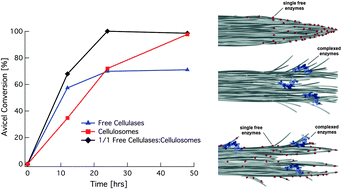Fungal cellulases and complexed cellulosomal enzymes exhibit synergistic mechanisms in cellulose deconstruction†
Abstract
Nature has evolved multiple enzymatic strategies for the degradation of plant cell wall

* Corresponding authors
a
Biosciences Center, National Renewable Energy Laboratory, 15013 Denver West Parkway, Golden, CO, USA
E-mail:
michael.resch@nrel.gov
Fax: +1 303-384-6363
Tel: +1 303-903-8934
b BioEnergy Science Center (BESC), National Renewable Energy Laboratory, 15013 Denver West Parkway, Golden, Colorado, USA
c Department of Biological Chemistry, The Weizmann Institute of Science, Rehovot, Israel
d National Bioenergy Center, National Renewable Energy Laboratory, 15013 Denver West Parkway, Golden, Colorado, USA
e Department of Chemical Engineering, Colorado School of Mines, Golden, Colorado, USA
Nature has evolved multiple enzymatic strategies for the degradation of plant cell wall

 Please wait while we load your content...
Something went wrong. Try again?
Please wait while we load your content...
Something went wrong. Try again?
M. G. Resch, B. S. Donohoe, J. O. Baker, S. R. Decker, E. A. Bayer, G. T. Beckham and M. E. Himmel, Energy Environ. Sci., 2013, 6, 1858 DOI: 10.1039/C3EE00019B
To request permission to reproduce material from this article, please go to the Copyright Clearance Center request page.
If you are an author contributing to an RSC publication, you do not need to request permission provided correct acknowledgement is given.
If you are the author of this article, you do not need to request permission to reproduce figures and diagrams provided correct acknowledgement is given. If you want to reproduce the whole article in a third-party publication (excluding your thesis/dissertation for which permission is not required) please go to the Copyright Clearance Center request page.
Read more about how to correctly acknowledge RSC content.
 Fetching data from CrossRef.
Fetching data from CrossRef.
This may take some time to load.
Loading related content
